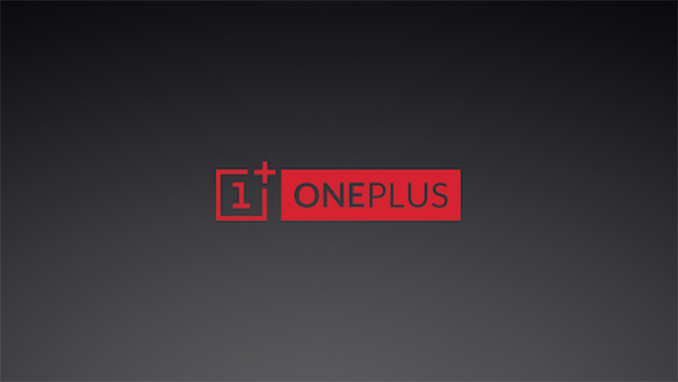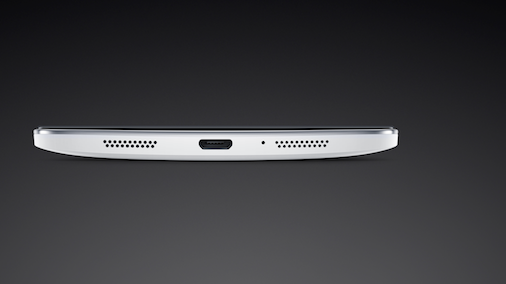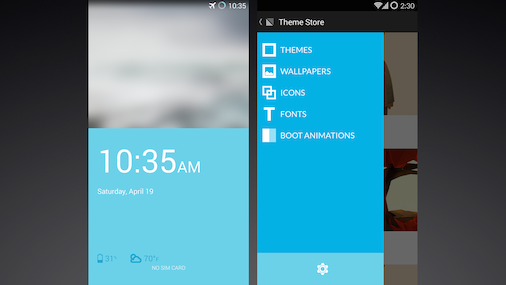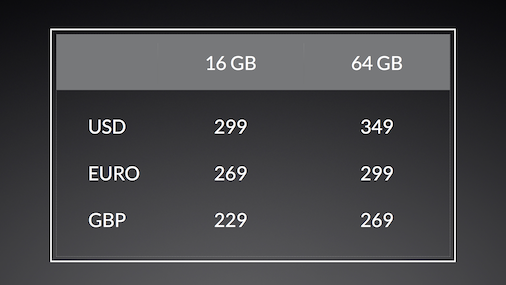OnePlus launches the OnePlus One: Initial Thoughts
by Joshua Ho on April 23, 2014 3:04 AM EST- Posted in
- Smartphones
- Android
- Mobile

Edit: In the time since the initial launch, there's been confirmation that the OnePlus One does in fact support 802.11ac. It's a single spatial stream part, Qualcomm's WCN3680.
In what has possibly been the most hyped-up launch in recent history, OnePlus has finally unveiled their new One. This is a smartphone that shares a great deal with the Oppo Find 7a, and it has been announced that Oppo is the company that will produce this phone. For those that haven't followed this company, OnePlus is a start-up that was founded last year in December by Pete Lau, former VP at Oppo.
To start off, this is a phone with a 5.5" 1080p display from JDI (Japan Display Inc.), and ships with a 2.5 GHz Snapdragon 801, which clearly shows the high-end aspirations for this phone. The rest of the specs can be seen below.
| Oppo Find 7a | OnePlus One | |
| SoC |
MSM8974ABv3 2.3 GHz Snapdragon 801 |
MSM8974ACv3 2.45 GHz Snapdragon 801 |
| RAM/NAND | 2 GB LPDDR3, 16GB NAND + microSD | 3GB LPDDR3, 16/64GB NAND |
| Display | 5.5” 1080p IPS LCD (JDI) | 5.5” 1080p IPS LCD (JDI) |
| Network | 2G / 3G / 4G LTE (Qualcomm MDM9x25 UE Category 4 LTE) | 2G / 3G / 4G LTE (Qualcomm MDM9x25 UE Category 4 LTE) |
| Dimensions | 152.6 × 75 × 9.2 mm, 170 grams | 152.9 x 75.9 x 8.9 mm, 162 grams |
| Camera |
13MP (4128 x 3096) Rear Facing, 1/3.06" CMOS size (Sony IMX214), F/2.0, 5MP FFC w/ F/2.0 aperture |
13MP (4128 x 3096) Rear Facing, 1/3.06" CMOS size (Sony IMX214), F/2.0, 5MP FFC w/ F/2.0 aperture |
| Battery | 2800 mAh (10.64 Whr) | 3100 mAh (11.78 Whr) |
| OS | Android 4.3 with ColorOS | Android 4.4 with CyanogenMod 11S |
| Connectivity | 802.11a/b/g/n/ac + BT 4.0, USB2.0, GPS/GNSS, MHL, DLNA, NFC | 802.11a/b/g/n/ac + BT 4.1, USB2.0, GPS/GNSS, MHL, DLNA, NFC |
| SIM Size | MicroSIM | MicroSIM |
As shown above, the Find 7a and the OnePlus One are extremely similar phones outside of a few key areas, with a thinner and somewhat lighter build on the OnePlus One, along with a larger battery, deletion of the microSD slot and a unibody construction that prevents easily swapping batteries. OnePlus has also detailed their curved back design, which goes from 4.6mm on the edge to 8.9mm in the middle, which means that the design is curved similarly to the One (M8) and other HTC designs, although without the associated pyramidal internal stack that would increase volumetric efficiency for such a design.
OnePlus is also pushing their dual stereo speakers, both of which are placed on the bottom. I'm not too sure what the point of this is though, as the speaker separation is almost nothing, although peak volume can increase through constructive interference.

Going through the marketing materials, there's quite a bit that OnePlus is advertising that isn't necessarily a point of differentiation. Things like Touch On Lens (TOL) and Content-Adaptive Backlight Control (CABC) are commonly used throughout the industry, and TOL has already been supplanted by in-cell touch technologies used by OEMs such as LG and Apple. CABC is a power-saving technique often seen in most LCD-screened phones, and is often identified as dynamic contrast due to some implementations having a visible flicker effect from image to image. The LTPS display is also nothing new, as most LCDs use such technology in order to have manageable levels of power consumption at the high pixel densities that most mobile displays have.The camera is also identical to the one found in the Oppo Find 7a, with no clear differentiation.
What is interesting is the UI, which runs a custom version of CyanogenMod 11. It seems to be a new skin over AOSP, and represents the first departure that I've seen by CyanogenMod from AOSP-UI in a long time. An example of the lock screen and theming application can be seen below. The phone also has a capacitive menu button with no multitasking button, so it'll be interesting to see if this will pass Android CTS as most of the major OEMs seem to have moved to home/back/multitasking configurations despite previously adhering to home/back/menu.

Outside of UI, pricing is also another key differentiator. The phone will come in two colors, silk white and sandstone black. There will also be custom backplates, with wood, kevlar, and denim planned. It seems that based upon the launch presentation that this is a concession done in place of creating a metal unibody design, as issues with RF performance were explicitly referenced. In the US, the 16GB variant will be 299 USD, and the 64GB variant will be 349 USD. At launch, an invite system is in place to handle demand, although it seems that general availability will happen in Q2 2014. Prices for the supported regions can be seen in the photos below.














67 Comments
View All Comments
NeBlackCat - Wednesday, April 23, 2014 - link
And by the way, I think you should admit, and learn from, your mistakes rather than trying to cover them. You have an intelligent (if sometimes drunk) readership, who understands that the odds of typo-ing 'USB 2.0' to 'USB 3.0' are rather small.JoshHo - Wednesday, April 23, 2014 - link
Apologies, the 2 and 3 key are rather close on my keyboard, I'll try to avoid making such typos in the future.NeBlackCat - Wednesday, April 23, 2014 - link
Get a proper keyboard then? Come on mate, that was an extremely unlikely typo but far more likely (and understandable) misreporting of an eagerly anticipated technological advance in consumer devices, which ARM development boards, eg. Odroid, have had for some time.JoshHo - Thursday, April 24, 2014 - link
No, I was always sure that the OnePlus One had microUSB 2.0 only, I didn't realize that I made a mistake until I woke up the next morning to read the comments. I will be sure to avoid such errors in the future.rocketbuddha - Wednesday, April 23, 2014 - link
@NeBlackCatHere is straight from the horse's mouth
http://oneplus.net/one#specifications
As per the page
http://oneplus.net/one#overview
64GB Sandstone Black
16GB White
Very ambiguous as to whether the other color is available at the storage option.
Might me a marketing 101 so as to increase the curiosity volume....
I am surprised that HTC has not come up with cudgels yet on the Term "ONE" as it is a very important part of their current marketing...
Company seems to be One Plus.
The phone seems to be named One (Which is where I am surprised no peep yet from HTC)
BT 4.1
Mkii - Wednesday, April 23, 2014 - link
Please OnePlus don't make world hell. Give as a micro sd card option..The HTC M8 looks awesome but the camera sucks. You got it almost there.. just give us the micro sd card slot.
64GB it is not enough, for people like me that are always on the road and wants to carry their music, videos, movies with it. Don't tell me about the cloud as travelling from country to country in Europe you are lucky if you get some "paid" wi-fi spot.
And if you can't give us the micro sd slot please give us a mature explanation why not.
It was going to be almost "one" of the happiest days of my life.. If it just would have a micro sd card slot.
NeBlackCat - Wednesday, April 23, 2014 - link
Would USB OTG and a decent thumb drive or SSD be of any use?Laststop311 - Thursday, April 24, 2014 - link
I would of liked to see wireless AC support, USB 3.0 with quick charge support, 128GB micro sdxc support and optical image stabilization with xenon flash and especially a larger camera sensorThe camera is a point of contention for me. The size of the sensor is the most important aspect of a high quality camera. The 1/3.06" sensor leaves some size to be desired at least the size of the lumia 1520's 1/2.5" sensor or better yet the lumia 1020's 1/1.5" sensor or BEST yet the largest sensor ever put into a phone the pureview 808's 1/1.2" sensor.
Super high megapixels sounds great but you sacrifice low light performance for better brightly lit photos. HTC had a good idea with the ultra pixels but they lowered the megapixels too far instead of making the sensor larger. They used a 1/3" sensor (same size as the oneplus).
This phone could of transcended all phones if they only included a 1/1" (or 1 inch) sensor size slightly bigger than the pureview 808 and largest phone sensor ever and instead of cramming tons of megapixels made the pixels mega ultra pixels by going even larger than htc's 2.0um and made them 2.5um light gobbling pixels. They could of had a 11MP 1/1" (or 1 inch) sensor with 2.5um double ultra pixels.
Lower light photos are what is truly important on a camera phone. When you are out with your friends at a restaurant or bar or many indoor locations the ability of low light capture is what decides if your photos are good and not the megapixel count. A 1 inch sensor and 2.5um pixels + a good optical image stabilization system would create the highest clarity best looking low light shots of any phone even the fabled lumia 1020 and pureview 808. And since the sensor is big enough to allow that large of pixels and still have an 11MP resolution when you do have to take those (not as frequent) sunny brightly lit shots you don't take a large downgrade in clarity compared to most phones brightly lit performance like what happened htc's 4MP ultra pixels. The other phones with 13MP, 20MP and even higher counts will perform the best in the sunny outdoors but many of us barely take photos in that situation (i'm usually sleeping during the day)
I don't really care about the few other missing features i mentioned but if the oneplus one would of released with a 1 inch camera cmos sensor with a lower 10-11 megapixel count and larger 2.5um sized "ultra" pixels and a nokia lumia 920 grade optical image stabilization system with a xenon flash in addition to the LED lights. It could of been a photographers dream phone. Sure there would of been a big bump on the back to fit the large sensor and xenon flash power delivery. But it would of been worth the bump when you had the best photos available from ANY phone. I would even have paid an additional 200 dollars so 550 dollars for 64GB if they would of added the more advanced and more expensive camera system.
I think another 200 sounds right for a sensor 3 times as large 1 inch vs 0.333 inch and the larger 6 element lens system that it would require, OIS system vs no OIS system, and the added xenon flash while keeping the LED lights as well.
They could even fork this version of the oneplus one as a different model so people that don't care about photography as much can just get this one cheap for 350. While the people that love the oneplus one but also want the best camera experience to EVER be in a phone can pay 550 which would still be one hell of a bargain for a top specced phone with the best camera ever to appear on a phone.
Laststop311 - Thursday, April 24, 2014 - link
Call it the Oneplus One Dark Photography EditionLaststop311 - Thursday, April 24, 2014 - link
And if possible if we are going to fit a 1 inch sensor in there maybe it is even possible to fit a 4/3" sensor which is a very common compact digital camera sensor with many varied and extremely mature lens setups. Then the sensor would be 4x larger and could step up to 3.0um ultra pixels or just add more to make its brightly lit pictures equal to the best out there without sacrificing the low light. I'd probably rather have the even larger pixels.